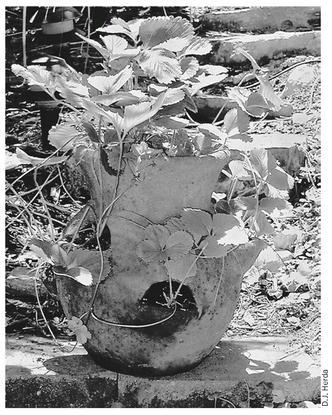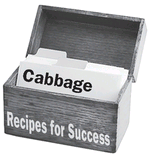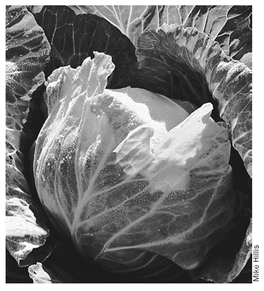2
Gone to Pot
I don’t own a garden.
I don’t miss it.
I own land.
And I own plants. Lots and lots of plants. Plants everywhere. But no “garden” per se.
What I do own instead of a garden are pots. Lots and lots of pots. Expensive pots, cheap pots, pots off the shelf, pots redux to make them look as if they’re not pots off the shelf and even homemade pots.
I own pots made out of clay and out of porcelain. I own pots made out of glass and out of plastic. I own pots made out of concrete aggregate, out of metal and out of resin. In short, if it can be shaped like a pot and made to hold water, I own it.
The reason is simple. I love pots. Or rather I love growing things in pots. The pots themselves are mostly an efficient means of preventing soil, water and plants from spilling out all over the floor.
But I don’t have to worry about that. From morning to night, I am surrounded by pots, which — by and large — do a remarkably effective job of containing what they were meant to contain. That makes pots very desirable things to own. In fact, if I had my way, I would own even more.
My typical day starts off much the way yours does. I get up in the morning, have a cup of coffee and stick a plant or two into a pot. I look around for plants that have outgrown their existing containers, and I re-pot them. I see what recently acquired plants I have sitting on my planting bench, and I pot them.
I take a look at how my existing pots look in the garden, on the patio, on the deck, on the veranda and in the house. I shift them around until I think they look better. I check the soil for dryness. I water some pots and skip over others. I make a mental note of what plants need to be repotted — or what plants will need repotting in the near future — and I marvel at the lushness of the growth all around me.
I pick a fig or two. I snatch a cherry tomato. I sniff the edible Nasturtium. I squeeze a lime. I smile.
And then I eat breakfast.
Well, okay, maybe it’s not your typical day, and maybe my pot fetish isn’t normal. But it could be. And perhaps it should be.
I grow everything in pots — well, nearly everything. My living room boasts several large pots containing majestic Ficus benjamina trees, spiraling rubber plants, several varieties of Dracaena, a few types of Philodendron , a pot full of sansevieria, a bearing banana tree and some ferns.
My dining room has an eight-foot tall corn plant to one side of the table. I used to have a Schefflera in the far corner, but the corner is dark and, after a year, the plant began showing the strain of too little light. I moved it out into the sunroom several weeks ago, where it is recovering nicely.
That’s another place I have plants, of course — the sunroom: Dracaena marginata, prayer plants, several Norfolk Island pines, a flowering bird of paradise, a weeping fig, a couple of tomato plants, an Aralia, a date palm, fresh basil, curly-leaf parsley, leaf lettuce, a ponytail palm, a couple of flowering succulents, a miniature kumquat tree, a dwarf lime tree, a few bamboo spikes and several varieties of cacti.
In short, with rare exception, I have plants growing in every room of the house.
I also have potted plants outdoors at my home here in southern Utah — lots of them. In flowerboxes, I have several varieties of sweet potato and yams, lots of herbs (sage, basil, oregano, numerous varieties of thyme, plus rosemary, chives and garlic), a couple of cape honeysuckle shrubs, flowering Alyssum and a few asparagus ferns.
On the patio are potted roses, rubber tree plants, tomato plants, both bulb and green onions, leaf vegetables (lettuce, spinach and edible kale), English ivy, Aloe vera, a few assorted ferns, some ground cover (mostly creeping Jennie and sweet woodruff), violets, Nasturtium, a burning bush shrub, baby tears, green and purple shamrock, Spanish daisies, numerous varieties of grass and some miscellaneous succulents. The fruits and veggies provide healthy fresh produce from mid-summer through the first frost (and sometimes beyond), while ornamentals provide a plethora of color to liven up the view from the patio chairs.
All in all, it’s a great way to wake up in the morning and a fantastic way to feel revived and refreshed — walking among the planted containers.
Good Harvests from Small Packages
A process known as square-foot gardening provides encouraging news for container gardeners who enjoy growing vegetables. In effect, it says you can plant crops closer together than usually recommended with good success, so long as you provide the basic nutrients the plants require. Think of it as no-till, no-dig, no-weed gardening. Since most crop plants require only six inches of soil in depth — twice that amount for root crops — pots lend themselves ideally to vegetable gardening.
As for pot diameter, broccoli, green beans and similarly sized plants do well with one square foot of surface area (a 12-inch pot), while tomatoes, zucchini and other larger plants do best in up to three square feet. That makes vegetable gardening in pots one of the most convenient and efficient uses of soil available.
Not even ponds are exempt. In them, I have a host of water and bog plants, including cattail, water hyacinth, water lettuce, duckweed, watercress, marsh pickerel, water celery, Cyprus grass, Cabomba, horsetail and pennywort, most of which are edible.
It sounds like a lot, and I suppose it is. With all these plants growing in my household, you might think we have our hands full. Yet, the care required for all of the benefits we reap is pretty much confined to a couple hours a week spent watering and a few minutes more each day plucking off old growth and checking on the health of the plants in general.
We spend another hour a week picking produce, trimming herbs and leafy vegetables, pulling bulb crops and otherwise harvesting our rewards, mostly in late summer and fall.
We invest another hour each week dead-heading spent flower buds (removing the old flower heads stimulates new growth and more blooms), pruning unwanted growth and training vining plants to grow where we want them to grow instead of where they’d prefer to grow, which is everywhere.
This strawberry pot filled with — what else? — strawberry plants requires little maintenance and spurs plants to keep growing and bearing every spring. Note the string-like runners that produce new plants for repotting.
Finally, we spend a good hour a week soaking in a hot tub.
For a total of about four hours’ worth of work a week, then (the soaking isn’t real “work”), we get to live in a veritable paradise of horticultural delights. From the most exotic faraway places in the world to some plants that grow wild right outside our own back door, we have them all growing in pots because we enjoy them all.
We enjoy the “work” of container gardening, too, if truth be known. Caring for plants is a bit like caring for pets, except without all of the drama and none of the fur balls.
Don’t get me wrong. We have cats that we love to death (along with the cat mint that they enjoy grazing), and we keep our outdoor ponds stocked with koi and goldfish. But, by and large, our “babies” are our potted plants. And the work we expend in keeping them looking good, keeping them growing and healthy and flowering and producing, is just the kind of work people today don’t get to enjoy often enough.
With all of these plants around, you’d think we’d be satisfied. Sure. Just about the way you’d expect Donald Trump to be happy with Trump Towers and not feel the need for more acquisitions.
The truth is that, so long as you garden — and especially when you container garden — you’re going to find new plants, new species and new varieties that you’re going to want to put in a pot just to have near you.
Me? I’m looking forward to the day when we have a home with enough space to allow us to grow some Japanese maple trees in pots. And perhaps a lilac shrub or two. And some more exotic fruit trees.
We currently have a few trees that are taller than I am — possibly seven or eight feet in height. But I suppose I won’t really be in Hawg Heaven until I look around the house at trees spiraling skyward, two or three stories tall, smiling down at me. Perhaps a weeping mulberry or a clump of tender white birch or even a coconut palm would also be nice. It will take one mighty big house to make that happen — and substantially larger pots, I know. But somehow I can’t help but think the effort would be worthwhile.
Besides, isn’t dreaming part of what life is all about? And isn’t container gardening just one more way to make your dreams happen?
01:00 IN A MINUTE
• If it grows anywhere, you can probably grow it in a pot.
• Growing fruit and vegetables in a pot is especially efficient, since it is a take-off of the “square-foot gardening” method, which relies on maximizing space and minimizing waste.
• Maintaining potted plants takes from a few minutes to a few hours each week, depending upon the number of potted plants you own.
• Dead-heading, or removing spent flower heads, will produce more vigorous plant growth and more blooms over the course of the growing season.
Cabbage (Brassica oleracea) Chinese Cabbage (Brassica rapa, Pekinensis Group)
Habit: Head and upright
Cultivars: Numerous cultivars exist, including:
• Cabbage: Bravo, Market Prize, Rio Verde, Savoy Express, Tropic Giant (hybrid) and Green Jewels (hybrid)
• Chinese cabbage: Pak Choi Type — Joi Choi (hybrid)
Seed or transplants: Both
Pot Size: Medium
Water: Water to provide a uniform moisture supply to the crop. The container should be watered in the morning so that the foliage is dry before dark. Water sufficiently to moisten the soil to a depth of at least six inches. If gardening in pots outdoors, maintain a constant uniform moisture supply to produce a high-quality crop and to have the spring crop mature before high summer temperatures set in.
Comments: Chinese cabbage forms dense heads that may be very upright and tall (Michihili types) or round and barrel-shaped (Napa types). The leaves are slightly wrinkled and thinner than the leaves of regular cabbage with wide, crisp midribs. When choosing what type of cabbage to grow, remember that the darker green leaf and the red varieties provide more nutrition than the light green ones.
Seeds: Plant seeds to a depth approximately twice the thickness of the seed; water and tamp soil firmly. Cover pot with a clear plastic container or wrap, and wait for germination. Keep soil moist but not saturated, and keep pot out of direct sunlight to avoid overheating. Uncover at the first sign of sprouts. Thin to approximately one plant per foot for head varieties.
Transplants: Place in hole no deeper than original root ball, and tamp around stem firmly.
Soil: Cabbage (Brassica oleracea, Capitata Group) grows well in a wide variety of soils, but it prefers a well-drained sandy loam with high organic matter content. Soil pH should be 5.8 to 6.5.
Insects: Several worms (imported cabbageworm, cabbage looper, diamondback moth caterpillar), harlequin bugs, cabbage maggots, aphids and flea beetles are the major insect problems. Solutions: Pick off and destroy larger worms, and spray the plant with biologically friendly non-detergent soap mixed with water (1T per gallon water) for smaller insects.
Cabbage (Brassica oleracea)
Diseases: Black rot, wire stem, damping-off, downy mildew, Alternaria leaf spot and watery soft rot are the major diseases. Cabbage is more susceptible to wire stem and downy mildew than is Chinese cabbage. Chinese cabbage is more susceptible to Alternaria. Black rot causes the most serious damage and appears as V-shaped lesions down the leaves before spreading into the water-conducting system of the plant. This disease is caused by a bacterium that is seed-borne or that can be transmitted by transplants. Warm, moist weather favors the disease. Solutions: Compost tea (see Chapter 15) contains organisms that attack fungal diseases and should be used as a supplement and treatment whenever possible. Otherwise, several commercially available fungicides (short-acting so as not to remain viable on the plant after harvest) are available online and at your local home and garden center. There is no control for black rot once it is established in a planting. Prevent the disease by purchasing transplants that are certified to be disease-free, or plant western-grown chemically treated seed.
Health Benefits: For the past two decades, researchers have understood the valuable role that phytonutrients play as antioxidants to disarm free radicals before they can damage human DNA cell membranes. But recently science has learned that phytonutrients in crucifers, such as cabbage, work at a much deeper level, actually signaling our genes to increase the production of enzymes designed to aid in the detoxification of harmful compounds — the ultimate body cleanser!
The phytonutrients in cruciferous vegetables initiate genes that play a complex role in placing into action dozens of detoxification enzyme partners, each balancing perfectly with the others. This natural synergy utilizes our cells’ own abilities to disarm and clear free radicals and toxins from our systems. These include carcinogens, the primary reason that crucifers lower our risk of cancer more effectively than any other fruit or vegetable. In fact, studies have proven that diets rich in cruciferous vegetables create a much lower risk of prostate, colorectal and lung cancer.
In a study of more than 1,000 men conducted at the Fred Hutchinson Cancer Research Center in Seattle, WA, those eating 28 servings of miscellaneous vegetables a week showed a 35 percent lower than average risk of prostate cancer, while those consuming only three or more servings of
cruciferous vegetables each week had a 41 percent lower prostate cancer risk.
11In addition to its cancer-preventive phytonutrients, cabbage is an excellent source of vitamin C, an antioxidant that helps protect cells from harmful free radicals. Cruciferous vegetables have also been beneficial in promoting women’s and gastrointestinal health, as well as defending against Alzheimer’s and various cardiovascular diseases.
Ready for the Kitchen: When plant is fully formed and deep in color, after approximately 90-100 days. Store in a refrigerator crisper to retain freshness.
Annual Savings: Approximately $45 per year per person on average.



